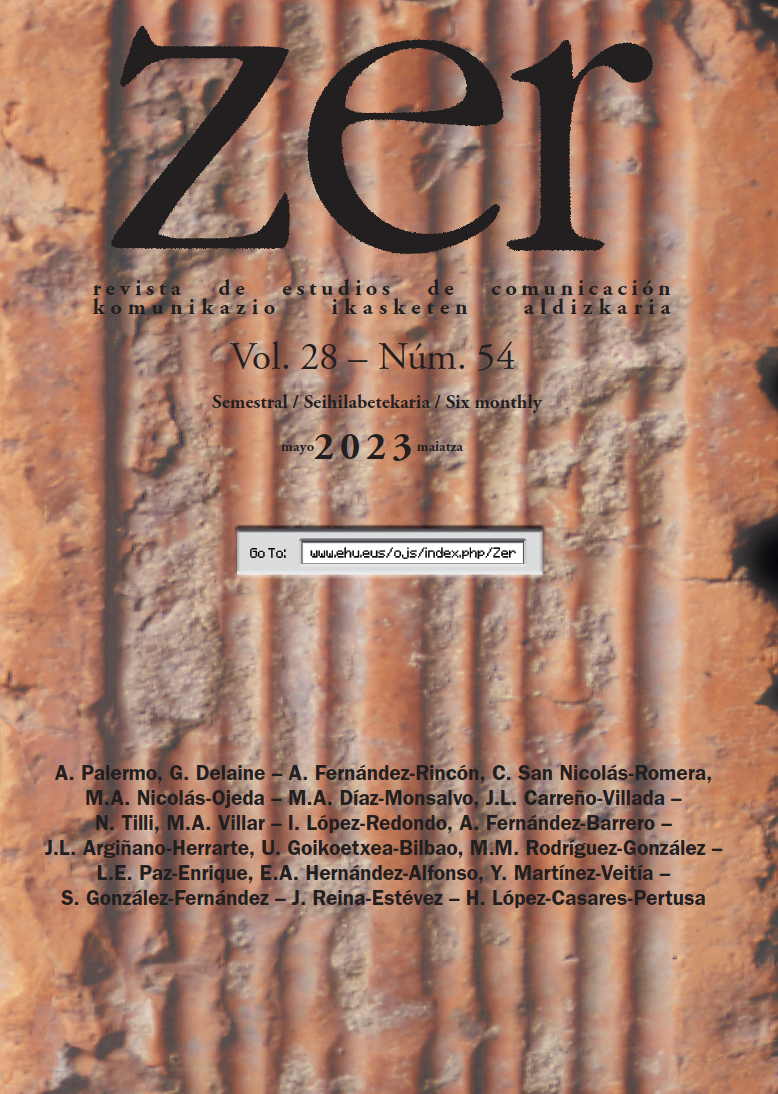La Fórmula 1 en las redes sociales: una estrategia digital innovadora
##plugins.themes.bootstrap3.article.main##
##plugins.themes.bootstrap3.article.sidebar##
Guillaume Delaine
Resumen
Esta investigación analiza el grado de implicación en la F1 a través de las redes sociales de los equipos que participan en el campeonato de la FIA. Los medios de comunicación clásicos se complementan ahora ahora a través de la producción de nuevos medios: publicaciones que invitan a los aficionados a interactuar, recreando así un ágora virtual, una comunidad federada por el intercambio en línea, en torno a producciones multimedia en tiempo real. La investigación realizada tiene como objetivo analizar, con una metodología cuantitativa, el Engagement Rate de los 10 equipos participantes en el campeonato de 2021, en Facebook e Instagram.
Cómo citar
##plugins.themes.bootstrap3.article.details##
Fórmula 1, Comunicación digital, Redes Sociales, engagement, fans
Adobe (2022). Your guide to social media engagement rates. Retrieved from https://www.adobe.com/express/learn/blog/what-is-a-good-social-media-engagement-rate
Cardon, D. (2011). Réseaux sociaux de l'Internet. Communications, 88, 141-148.
Charon, J. M. (2011). Les médias à l’ère numérique. Les Cahiers du journalisme, 22(23), 1526.
Desbordes, M., Hautbois C. (2020) . Management du sport 3.0 - Spectacle, fan experience, digital . Economica.
FIA (2021). Activity Report. Retrieved from https://www.fia.com/fia-activity-reports
Filo, K., Lock, D., & Karg, A. (2015). Sport and social media research: A review. Sport management review, 18(2), 166-181.
Formula1.com. (2021). New global fan survey reveals Formula 1’s most popular team and driver. Retrieved from https://www.formula1.com/en/latest/article.new-global-fan-survey-reveals-f1s-most-popular-team-anddriver.2evqTWEPsWYeBlw9vmSyBs.html
Forrester. (2015). Instagram Is The King Of Social Engagement. Retrieved from https://www.forrester.com/blogs/14-04-29 instagram_is_the_king_of_social_engagement/
Fournier, S., Avery, J. (2011). Managing brands by managing brand relationships. Perspectives on Brand Management, 225-248.
Gensler, S., Völckner, F., Liu-Thompkins, Y., Wiertz, C. (2013). Managing brands in the social media environment. Journal of interactive marketing, 27(4), 242-256.
Girón Santos, M. (2015). Redes sociales y Fórmula 1. Análisis de las interactividad de los pilotos durante el Campeonato Mundial de 2014. Index. Comunicación, 5(1), 123–153.
Holbrook, M. B., Hirschman, E. C. (1982). The experiential aspects of consumption: Consumer fantasies, feelings, and fun. Journal of consumer research, 9(2), 132-140.
Hootsuite. We Are Social. (2022). DIGITAL 2022. Le rapport mondial de l'évolution du numérique. Retrieved from https://wearesocial.com/fr/blog/2022/01/digital-2022/
Horne, B. D., Nevo, D., & Adalı, S. (2019). Recognizing Experts on Social Media: A Heuristics-Based Approach. ACM SIGMIS Database: the DATABASE for Advances in Information Systems, 50(3), 66-84.
Hull, K. (2014), A hole in one (hundred forty characters): A case study examining PGA Tour golfers’ Twitter use during the Masters, International Journal of Sport Communication, Vol.7, pp.245–260.
Kaplan, A. M., Haenlein, M. (2010). Users of the world, unite! The challenges and opportunities of Social Media. Business horizons, 53(1), 59-68.
Kassing, J. W., Sanderson, J. (2010). Fan–athlete interaction and Twitter tweeting through the Giro: A case study. International journal of sport communication, 3(1), 113-128.
Lebel, K., Danylchuk, K. (2012). How tweet it is: A gendered analysis of professional tennis players’ self-presentation on Twitter. International Journal of Sport Communication, 5(4), 461-480.
Littlejohn, S. W., Foss, K. A. (2005). Theories of Theories of human communication. Australia : Wadsworth series in communication studies.
Miller, D., Sinanan, J., Wang, X., McDonald, T., Haynes, N., Costa, E., Nicolescu, R. (2016). How the world changed social media. London : UCL Press Discovery.
Nankervis, B., Ferguson, L., Gosling, C., Storr, M., Ilic, D., Young, M., Maloney, S. (2018). How do professional Australian Football League (AFL) players utilise social media during periods of injury? A mixed methods analysis. Journal of science and medicine in sport, 21(7), 681-685.
Parganas, P., Anagnostopoulos, C., Chadwick, S. (2017). Effects of social media interactions on brand associations: A comparative study of soccer fan clubs. International Journal of Sports Marketing and Sponsorship.
Pedersen, P.M., Miloch, K.S. and Laucella, P.C. (2007), Strategic Sport Communication, HumanKinetics, Champaign, IL.
Proulx, M., Shepatin, S. (2012). Social TV: how marketers can reach and engage audiences by connecting television to the web, social media, and mobile. John Wiley & Sons.
RIVAL IQ. (2023). 2023 Social Media Industry Benchmark Report. Retrieved from https://www.rivaliq.com/blog/social-media-industry-benchmark-report/
Ruihley, B. J., Runyan, R. C., Lear, K. E. (2010). The use of sport celebrities in advertising: A replication and extension. Sport Marketing Quarterly, 19(3), 132.
Sanderson, J., Hambrick, M. E. (2012). Covering the scandal in 140 characters: A case study of Twitter’s role in coverage of the Penn State saga. International Journal of Sport Communication, 5(3), 384-402.
Sobry, C., Cernaianu, S. (2022). Sport Tourism and Local Sustainable Development. Cambridge Scholars Publishing.
Sonnac, N. & Gabszewicz, J. (2013). L'industrie des médias à l'ère numérique. Paris: La Découverte. https://doi.org/10.3917/dec.sonna.2013.01
Tribou, G., Dermit, N., Wojak, C. (2018). Management du sport-5e éd.: Marketing et gestion des clubs sportifs (Vol. 1). Dunod.
Wakefield, K. L., Blodgett, J. (2016). Retrospective: The importance of servicescapes in leisure service settings. Journal of Services Marketing.
Williams.J, Chinn.S. (2010) Meeting Relationship-Marketing Goals Through Social Media: A Conceptual Model For Sport Marketers. International Journal of Sport Communication. 3, pp.422-437.
Witkemper, C., Blaszka, M., & Chung, J. (2016). Establishing a Typology of Social Media Uses in the Sport Industry: A Multidimensional Scaling Study. Communication & Sport, 4(2), 166–186.

Esta obra está bajo una licencia internacional Creative Commons Atribución-NoComercial-SinDerivadas 4.0.
(c) UPV/EHU Press


 https://orcid.org/0000-0003-3326-6246
https://orcid.org/0000-0003-3326-6246